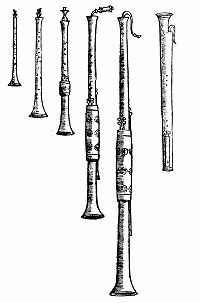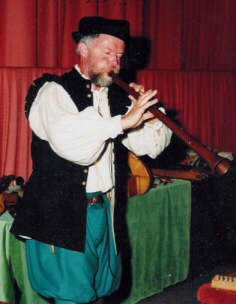- The raising of the Mary Rose began to have special meaning for students of early music when it was announced in the popular press that finds included musical instruments. A still shawm, a precursor of the modern oboe, was found on the ship. Something that had been written about in accounts of the time could now be reconstructed and played. It sounds rather like a kazoo.
- Tudor wind instruments
- Tudor musical instruments were used in various combinations which provided the Tudors with the opportunity to create unusual and creative music, a forerunner to the modern orchestra. Their collection of Wind musical instruments included the musical instruments from the Medieval period together with the musical instruments which emerged during the Tudor Period. Wind instruments consist of a tube containing a column of air which is set into vibration by the player blowing into, or over, a mouthpiece set into the end of the tube.

The Shawm
The shawm is a long, straight wooden instrument with a bell, played with a double reed similar to a small bassoon reed. Like many European instruments, the shawm started life as an Arabic instrument. Instruments very much like the medieval shawm can still be heard in many countries today, played by street musicians or sometimes by military bands. The latter use would be familiar to crusaders, who often had to face massed bands of saracen shawms and nakers, used as a psychological weapon. It must have had a profound effect, as the shawm was quickly adopted by Europeans, for dancing as well as for military purposes. The standard outdoor dance band in the fifteenth century consisted of a slide trumpet playing popular melodies, while two shawms improvised counter melodies over it - rather like jazz.
By the early sixteenth century, the shawm had undergone considerable development. Its initially harsh tone was mellowed by almost doubling its length, the extra tubing acting to modify the harmonics. Its grand, majestic sound, particularly when played in consorts of several sizes, was much in demand by civic authorities, and the shawm was standard equipment for the town bands, or waits. These were originally night-watchmen, paid to keep watch on the walls at night, and equipped with shawms (cheaper than trumpets) to warn of danger, sound the all-clear, and so on. The skills they developed on the shawm, however, and the resulting demand for their services for both civic and private functions, meant that by the sixteenth century their actual role was as town musicians, and an apprentice wishing to be employed as a town wait required proficiency on at least ten instruments
 References:http://news.bbc.co.uk/1/hi/magazine/7038519.stm http://www.the-tudors.org.uk/tudor-wind-musical-instruments.htm http://www.richard-york.co.uk/past/rtreeds.html EEBO, Hall, Edward, d. 1547. |
